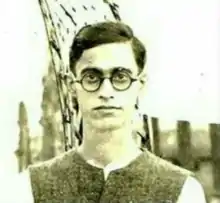Bhagabati Charan Panigrahi
Bhagabati Charan Panigrahi (1907 – 23 October 1943)[1] was an Indian Odia writer and politician. He was a founder and also the first secretary of Communist Party of Odisha. He wrote around a dozen short stories before his mysterious death in 1943.[2]
Bhagabati Charan Panigrahi | |
|---|---|
 | |
| Born | 1907 |
| Died | 23 October 1943 (aged 35–36) |
| Nationality | Indian |
| Occupation | Writer, politician |
Literary career
Bhagabati Charan Panigrahi, in his short literary career, wrote around 12 short stories. One of his notable short stories was Shikaar. The story captured the life of the tribal communities of Odisha, and the exploitation by British to control and suppress their revolt.[3] The story was made into a film Mrigayaa (1976) by Mrinal Sen. In 2016, an Odia language play was also written and staged based on the same story.[4]
In November 1935, in collaboration with Ananta Patnaik and others, he formed a literary organisation "Nabayuga Sahitya Sansad" (transl. New Age Literary Society).[5] Very soon it became famous and played significant role to foster new ideas in modern Odia literature.[6][7] In 1936, he edited a magazine called Adhunika.[6]
Short stories
The 12 stories written by Bhagabati Charan Panigrahi are:[7]
- Shikar
- Mimansha
- Junglee
- Arambha
- Oh Sesha
- Mrutyura Chetana
- Jeevanarah Samadhi
- Banchita
- Samayatita
- Jhada
- Misranka Kopa
- Majlish
Political career
Bhagabati Charan, in his youth and in the beginning of his political career was inspired by Mahatma Gandhi's political ideology. Later he became associated with Congress Socialist Party.[5] Panigrahi, along with Guru Charan Patnaik, and Comrade Prananath Patnaik formed the Communist Party of Odisha on 1 April 1936. Panigrahi was the first state secretary of the party.[8] Panigrahi was associated with the party and the communist ideology till his death.[9]
Death
On 23 October 1943, Panigrahi was found dead under mysterious circumstances At that time he was undergoind detention by the British. The death certificate reported he died because of unknown illness, however there was speculations that he was tortured to death.[10]
See also
- Fakir Mohan Senapati, Odia writer
References
- Subash Chandra Padhi; A. Sobha Rani (2004). Peasants and land reforms in Orissa, 1936-1976. R.N. Bhattacharya. p. 31.
- Mohan Lal (1992). Encyclopaedia of Indian Literature: Sasay to Zorgot. Sahitya Akademi. pp. 4062–. ISBN 978-81-260-1221-3.
- "'Ghinua' wins hearts of people in Paradip". The Times of India. Retrieved 4 May 2020.
- Encyclopedia Britannica (2003). Encyclopaedia of Hindi Cinema. Popular Prakashan. pp. 338–. ISBN 978-81-7991-066-5.
- Pati, Biswamoy (2012). "Creativity and the Left Cultural Movement in Orissa, c. 1930–40". Social Scientist. 40 (1/2): 31–40. ISSN 0970-0293. JSTOR 23124195.
- "Bhagabati Panigrahi: A Tribute". OdishaPlus. 23 October 2019. Retrieved 4 May 2020.
- "Fair launch for Panigrahi's anthology". The Telegraph (India). Retrieved 4 May 2020.
- "History of CPI(M) Odisha". www.cpimodisha.org. Retrieved 5 May 2020.
- "Translating Maxim Gorky'sThe Mother in Odia" (PDF). p. 97. Retrieved 5 May 2020.
- "Bhagabati Panigrahi birth anniv held". The Pioneer. Retrieved 4 May 2020.